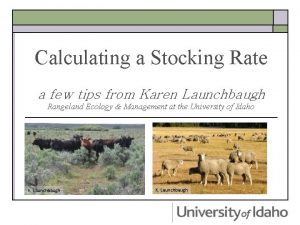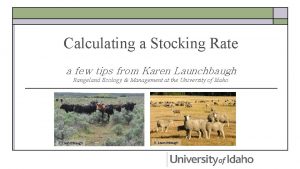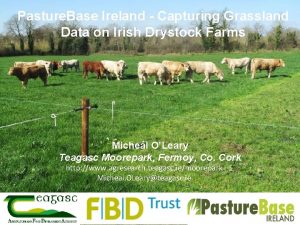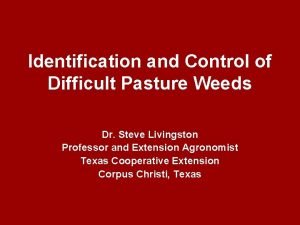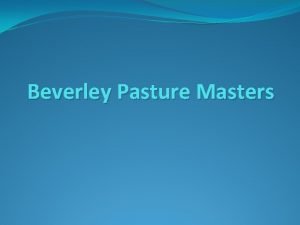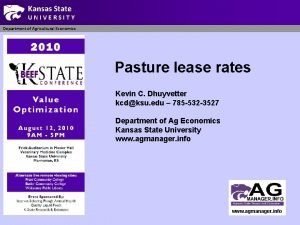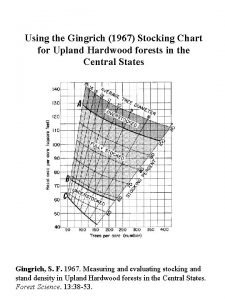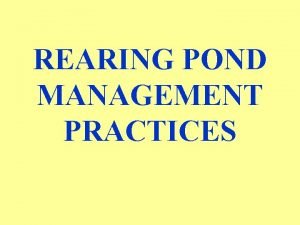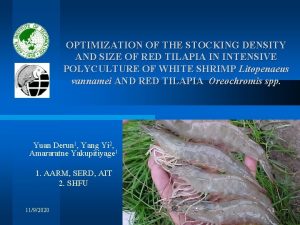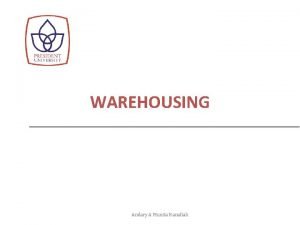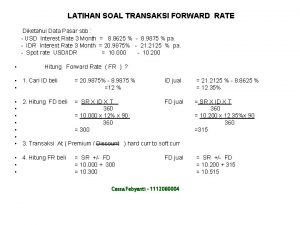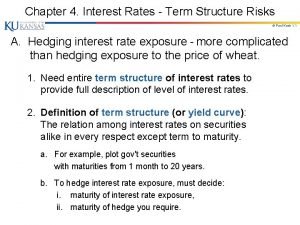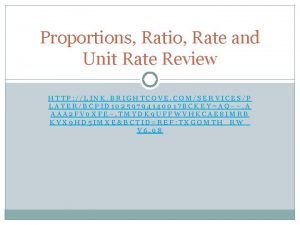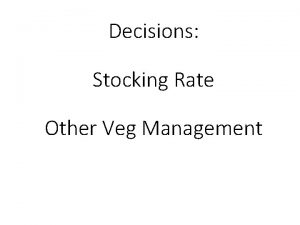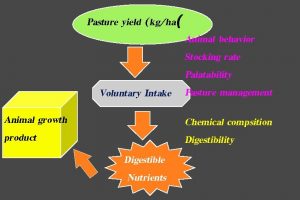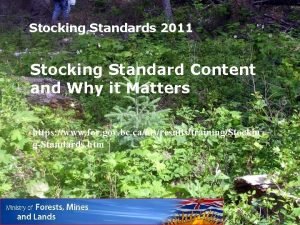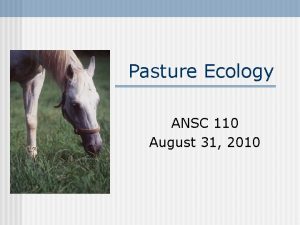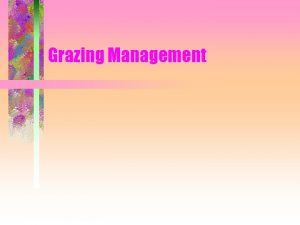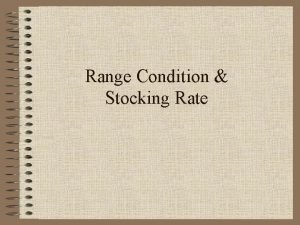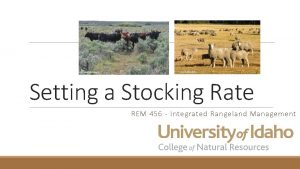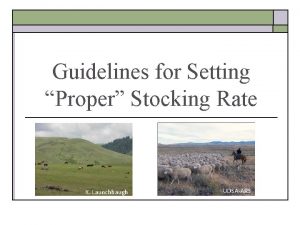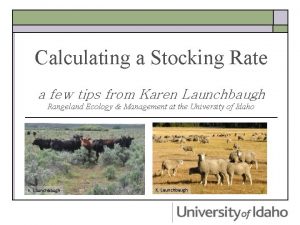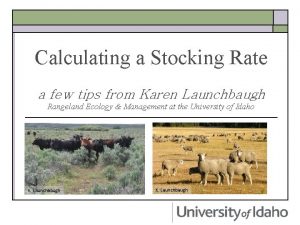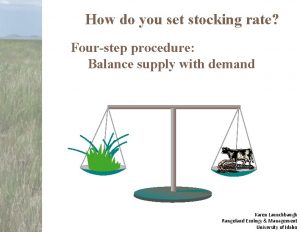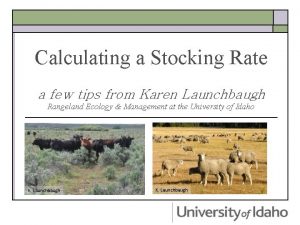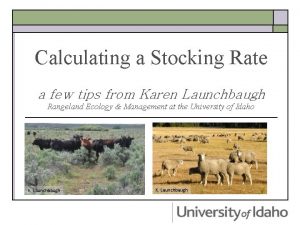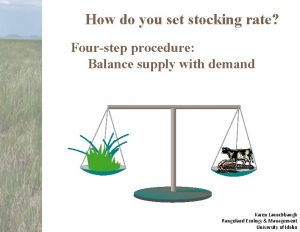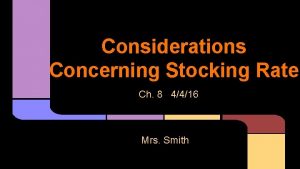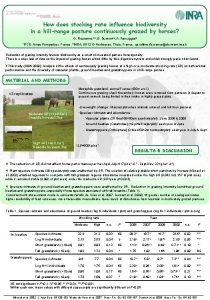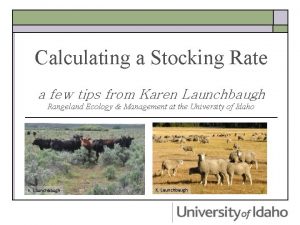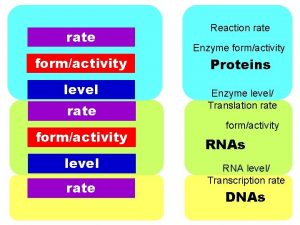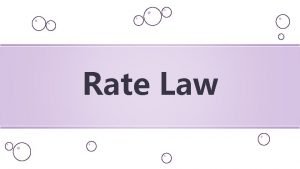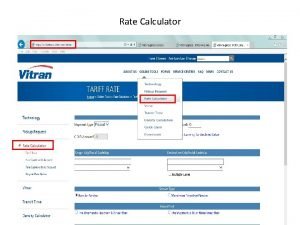Stocking rate pasture production animal production ha animal


























- Slides: 26

Stocking rate pasture production = animal production / ha =animal production / head * no of animal / ha =animal production / head * stocking rate

Animal unit 400 kg Steer = 1 AU. Calf (1 -8 mo) = 0. 35 AU. Weaner (8 -12 mo) = 0. 4 AU. Steer (1 -2 yr) = 0. 87 AU. Breeder Cow = 2. 0 AU. Bull = 2. 0 AU 1 AU. = 40 kg Merino = 1 dse. Wether = 1 dse. Maiden ewe = 1 dse. Lamb = 0. 5 dse. Breeding ewe = 1. 7 dse. Ram = 1. 7 dse. = dry sheep equivalent 8 dse.

F Carrying F Grazing capacity = pressure = utilise / production = feed demand / pasture mass = feed demand / head * no. of animal / ha pasture mass / ha = no. of animal / pasture area ?

Animal production / head animal production / ha The relationship between grazing pressure or stocking rate on animal production per head and per area. Grazing pressure

Factors control optimum stocking rate F F pasture growth rate availability of pasture mass to animal (allowance( F nutritional quality F botanical composition & ground cover F seasonal variation F type of enterprise and animal products

Pasture growth rate F rainfall Pasture availability LWG )kg/head/wk( (seasonal( F soil fertility F farm management Kikuyu grass (Pennisetum clandestinum) sward Pasture availability (allowance; kg/head(

LWG vs N availability FN < 4 kg/head N = 36 kg/head N 0 N 134 LWG = 0. 8 kg/head/d N 336 LWG )kg/ha( LWG )kg/head( F optimum LWG is negative 1612 8 6 4 2 Stocking rate (AU/ha( N 672

Fertilizer management on botanical composition and carrying capacity of pasture F Heteropogon contortus + Stylosanthes humilis carrying capacity = 0. 7 AU. /ha F if SR = 1. 1 AU. /ha less pasture mass and more weed (Fimbristylis dichotoma( F if + 250 kg P / ha of Super Phosphate more pasture mass and carrying capacity = 1. 2 AU. /ha

Accessibility of forage to animal (Pasture allowance( F Road & walk way F Shelter & pen feeding F Continuous grazing systems vs. working hour grazing time F Drinking water : 5 km for cattle, 1. 5 km for small ruminants F Fencing

Nutritive value of pasture F Selective grazing = ������������������ F Intake and digestibility are limited by nutritive value F Fertilizer input will enhance intake and nutritive

Stocking rate vs botanical composition Species Chloris gayana Digitaria decumbens Paspalum commersonii Paspalum dilatatum Desmodium uncinatum Desmodium intortum Lotononis binensii Trifolium repens others Stocking rate (head/ha( 1. 22. 5 7 17 20 30 5 3 33 13 0 1 1 14 2 1 9 5 22 16

Effect of SR on BC of shade intorelant spp. Attribute LWG (kg/ha) SR (AU. /ha( 1. 7 2. 5 3. 3 117 118 119 Pasture yield (kg/ha( Total S. humilis %legume N yield (kg/ha) %N in pasture 2 170 2 850 3 170 1 640 1 920 1 840 75 67 58 41 48 49 1. 88 1. 68 1. 54

Under grazing Optimum Over Low SR Optimum Over Grazing pressure Animal production / ha Animal production / head Mott (1960)’s model

LWG (kg/ha( Yh = a SR - b SR 2 6543215. Stocking rate (AU. /ha( LWG = a - b (SR( a reflect to nutritive value of pasture and genetic potential of animal b reflect to pasture mass or yield or allowance or response of pasture to stocking rate

Sward structure F Intake , Eadible or utilizable =< pasture mass or yield F Sward density = structure = bulk density = yield/area/height of pasture F Animal will selective graze at top of sward, then if forced by high SR or longer interval it will graze pasture of lower quality hence bite size and rate will be affected, since these depend on bulk or sward density

Pasture utilization period F Grazed / cut period – defoliation regimes – trampling – excretion – seasonal – continuous parasite cycle F Rest period – regrowth – weed control – irrigation – fertilizer application – flowering and seed production – altering life cyle of parasite

General guide for optimum stocking rate (after Jones, et al. 1984( Subtropical Total rainfall tropical temperate N short wet )mm/yr) legume fertilizer season long wet N season fertilizer 0. 8 -1. 5 750 1. 0 -2. 5 2 -4 0. 3 -1. 0 -- 1. 0 -3. 0 1000 1. 5 -3. 5 3 -6 0. 5 -1. 5 -3. 0 3 - 4 -7 0. 7 -1. 5 2. 0 -4. 0 5 - 2. 0 -5. 0 5 -8 1. 0 -2. 0 3. 0 -4. 0 7 - 1. 5 -3. 0 2. 0 -4. 01500 2000

Grazing systems F Continuous F Rotational F Repeated F Strip ������� seasonal ������ F Creep ��������� F Defered F Zero ����������� �������

Stocking rate & grazing system F Set stock F Variable stock – buying – selling F Continuous grazing system F Rotational grazing system

Continuous vs rotational grazing system on LWG (kg/ha/d) of beef grazed Panicum maximum and Macroptilium atropurpureum cv. Siratro sward Continuous 14 days on 7 days on 28 days off 35 days off Dry season 1. 14 1. 03 0. 77 Wet season 1. 42 1. 38 1. 28 3 -5 days on 7 days on 14 days off 28 days off Dry season 1. 30 0. 95 Wet season 2. 20 2. 28

When to graze / rest? F Stock in (graze( – high pasture growth rate – not in poor conditions – have longest rest period F Stock out (rest( – low pasture mass harmful to the regrowth – low nutitional status – poor animal growth – invasion of weeds

Why rest or rotation the pasture? F to control botanical composition F to have seed set and seed soil reserved F to control parasite life cycle F for other animal management eg. vaccination, sanitation, reproductive management (AI( F for easier farm amnagement eg. fertlizer application, hay or silage making, fencing

Electric fence F Three types of fencing : perimeter, permanent subdivision, and temporary subdivision F voltage generator (energizer( F wire fencing, Polywire, Hot-tape, Electric netting, Hi-tensile wire, Barbed wire F post F is it cheap? F design of the fencing and paddock system

Electric fence 220 v. in Energizer (voltage generator( Joule = 1 watt/sec controller switch gate post corner post


How to determine paddock size and number for rotational grazing system (After Gerrisk, JR. 1992( F How many animal and what are their size? F Feed requirement (cow / bull = 2. 5% of body weight , and calf = 3. 0% of body weight( F What is the desired % of pasture utilization (eg. 70%( F What is the pasture yield (eg. 3000 kg/rai( would you like the paddock to be rotated (eg. 7 days graze 35 days rest( F How F Determine the size and number of required paddock
 Pre stocking management
Pre stocking management Calculate stocking rate
Calculate stocking rate Calculate stocking rate
Calculate stocking rate Apa itu pre-production?
Apa itu pre-production? Deers pasture in to kill a mockingbird
Deers pasture in to kill a mockingbird Pasture base
Pasture base What is this weed?
What is this weed? Pasture master
Pasture master Pasture rent for cattle in kansas
Pasture rent for cattle in kansas Pasture sentence
Pasture sentence Pasture pals equine rescue
Pasture pals equine rescue Gingrich stocking chart
Gingrich stocking chart Post stocking management
Post stocking management Rearing pond management
Rearing pond management Stocking density of tilapia
Stocking density of tilapia Full line stocking warehouse
Full line stocking warehouse Bluestocking society
Bluestocking society Break-bulk, consolidation and postponement are functions of
Break-bulk, consolidation and postponement are functions of Cap rate interest rate relationship
Cap rate interest rate relationship What is real interest rate and nominal interest rate
What is real interest rate and nominal interest rate Relative growth rates
Relative growth rates Contoh soal spot rate dan forward rate
Contoh soal spot rate dan forward rate Determination of exchange rate
Determination of exchange rate Bootstrapping spot rates
Bootstrapping spot rates 1 year forward rate formula
1 year forward rate formula Difference between rate and unit rate
Difference between rate and unit rate Channel capacity planning
Channel capacity planning

